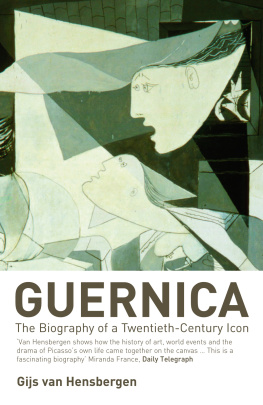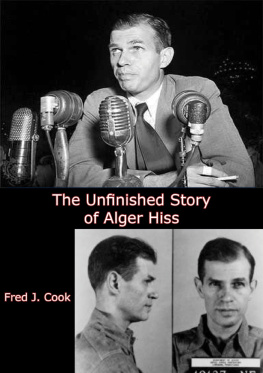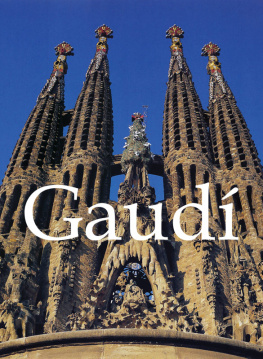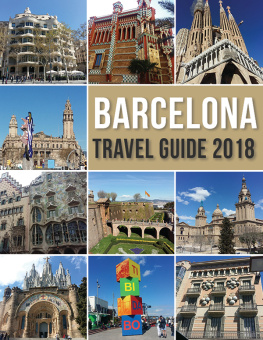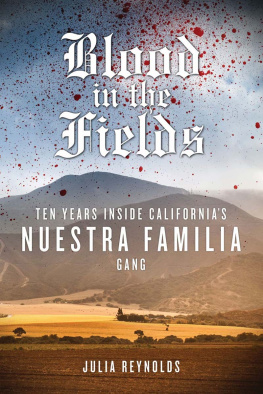Gijs van Hensbergen - The Sagrada Familia: The Astonishing Story of Gaudí’s Unfinished Masterpiece
Here you can read online Gijs van Hensbergen - The Sagrada Familia: The Astonishing Story of Gaudí’s Unfinished Masterpiece full text of the book (entire story) in english for free. Download pdf and epub, get meaning, cover and reviews about this ebook. publisher: BLOOMSBURY PUBLISHING, genre: Detective and thriller. Description of the work, (preface) as well as reviews are available. Best literature library LitArk.com created for fans of good reading and offers a wide selection of genres:
Romance novel
Science fiction
Adventure
Detective
Science
History
Home and family
Prose
Art
Politics
Computer
Non-fiction
Religion
Business
Children
Humor
Choose a favorite category and find really read worthwhile books. Enjoy immersion in the world of imagination, feel the emotions of the characters or learn something new for yourself, make an fascinating discovery.

- Book:The Sagrada Familia: The Astonishing Story of Gaudí’s Unfinished Masterpiece
- Author:
- Publisher:BLOOMSBURY PUBLISHING
- Genre:
- Rating:3 / 5
- Favourites:Add to favourites
- Your mark:
- 60
- 1
- 2
- 3
- 4
- 5
The Sagrada Familia: The Astonishing Story of Gaudí’s Unfinished Masterpiece: summary, description and annotation
We offer to read an annotation, description, summary or preface (depends on what the author of the book "The Sagrada Familia: The Astonishing Story of Gaudí’s Unfinished Masterpiece" wrote himself). If you haven't found the necessary information about the book — write in the comments, we will try to find it.
The Sagrada Familia: The Astonishing Story of Gaudí’s Unfinished Masterpiece — read online for free the complete book (whole text) full work
Below is the text of the book, divided by pages. System saving the place of the last page read, allows you to conveniently read the book "The Sagrada Familia: The Astonishing Story of Gaudí’s Unfinished Masterpiece" online for free, without having to search again every time where you left off. Put a bookmark, and you can go to the page where you finished reading at any time.
Font size:
Interval:
Bookmark:

THE SAGRADA FAMLIA
For Deborah Chambers, La Catalana,
whose kindness and support has meant so much
BY THE SAME AUTHOR
Antoni Gaud
Guernica: The Biography of a Twentieth-century Icon

CONTENTS
BEHIND THE FAADE
Gaud, possibly more than any other architect in history, has been totally misunderstood. Many people take Gauds buildings at face value. They wonder wide-eyed at the audacity, the orgy of colour, the engineering brilliance and outrageous daring, the sensuous surfaces that invite a touch, the wild and wonderful subject matter of dragons and skulls and the gingerbread-style houses made as if copied straight from the nightmare pages of Grimms Hansel and Gretel. What they often fail to do is look behind the seductive, sometimes frightening, faade.
Of all of Gauds buildings, the Sagrada Famlia a true lifes work is by far the most puzzling and the most quixotic. Its ambition seemingly knows no bounds, and its complex narrative is as mystifying as the visions that Saint John recorded on Patmos, which were later transformed into the Book of Revelation.
For the reader expecting a standard guidebook with an easy route to follow, and some simple observations followed by the odd suggestion for what else to see, this is not for you. The Sagrada Famlia is already so well publicised, so often visited, so often photographed that as the icon for Barcelona, it appears to need no introduction. That is, of course, a wholly simplistic approach to Gauds fantastically complex cathedral. For more than a century, the real Sagrada Famlia has somehow managed to successfully hide itself behind the blinding glare of the spotlight out there in full public view.
If Gauds buildings were misunderstood, so was he. Gaud as a man was a fascinating catalogue of contradictions: he was both revolutionary and deeply conservative; massively ambitious yet also humble; at the cutting edge yet deliberately medieval; pig-headed and irritable, yet also patient and kind; he was almost the epitome of the Franciscan happiest when meditating and communing with nature; yet he was also a passionate Catalan nationalist but, paradoxically, at the same time always reaching out towards the universal in his aspirations and ideals. Catalan identity is often described as representing the complex fusion of the two creative extremes embodied in the dialectically opposed concepts of seny and rauxa cold common sense, versus sometimes explosive outbursts. Gaud was all of this and more.
Part of the reason for dismissing Gaud so easily as a mere theatrical showman is partly his own fault, or rather the fault of his sheer approachability. For many years, Gaud was deemed far too popular and lightweight for architectural historians outside of Catalonia to take him seriously. He was also seen as far too eccentric, too bizarre and, in Catalonia, the land of Salvador Dal, almost too obviously surrealist and actually downright strange.
Gaud is a total one-off. But Dals obsessive interest in Gaud did the architect no favours. In 1933 in the surrealist magazine Minotaure, in an article entitled The Terrifying and Edible Beauty of Art Nouveau Architecture, Dal eulogised, rhapsodised then sacrificed Gauds architecture on the altar of his own perverse ego. As always, Dal was far cleverer than he gave himself credit for. Gauds architecture was sensual, soft, erotic, inviting touch. It was like an ornamental confectioners table, Dal said, and he was right it does have the faint echo of those great pices montes of chocolate, icing and spun sugar constructed by the legendary Antonin Carme for the banquets of tsars, kings and emperors. It was Carme the first superstar chef who, puffed up with the pride of his profession, made the rather silly claim that architecture was the most noble of the arts and that pastry was the highest form of architecture. However, even today Christian Escriba, Catalans celebrated chocolatier, is known to construct and carefully mould the odd version of a Gaud house in chocolate in direct homage to his two masters, the two Antonis, Carme and Gaud.
Its no secret that Ferran Adri, the worlds most famous chef, has also frequently looked to Gaud for inspiration.
But Adris adulation goes right to the crux of the Gaud problem. Seduced by the surface, we are less likely to look behind the scenes. And this is where Ferran Adri can help us out. Because what we see in Adris extraordinary culinary creations is a search for the science and the hidden structures in the nature of food. And by digging even deeper, Adri, like Gaud, is hell-bent on the labyrinthine search for the source of creativity itself.
Dals support for what he saw as the delirious architecture of Gaud certainly touched a raw nerve. Gaud is popular, massively so. He gives joy fa goig, as he would say in Catalan. But the joy that Gaud gives comes at the cost of his suffering, of rigorous self-discipline, of painstaking research, and also by the grace of his engineering genius. Finally, of course, right at the centre of his work sits his profound Catholic faith like a hard kernel, inviolate and unbreakable. The Sagrada Famlia is so unique, and so closely associated with Barcelona, that it is often forgotten that it grew out of a pan-European Catholic revival.
In an age when we are so often told that religion is dying, except, of course, when it manifests itself as a good reason for going to war, it is perhaps strange that a building project on the scale of the Sagrada Famlia still continues to forge ahead.
The Sagrada Famlia is a unique project that is slowly reaching its long-awaited end. If all goes to plan, the gigantic dome, which will double the existing buildings height, will be topped out in 2026 to celebrate the centenary of Gauds death. Like the construction of all churches, it is really in the end that we find the beginning. And the Sagrada Famlia will be no exception.
What I hope to offer the reader is an insight into the creative genius that is Gaud: to trace the development of the Sagrada Famlias evolution from expiatory temple to basilica, and open a window onto its complex Christian narrative. It is a fascinating story that started with the dreams of an eccentric Barcelona bookseller in the mid-nineteenth century to find a way of celebrating the life of the holy family. Today we witness the near completion of this extraordinary high-tech build. From beginning to end there have been planning battles, misunderstandings, and an alleged attempt to blow it up, and, of course, the tragic death of Gaud run over by a tram en route to the ritual of his daily confession at Saint Felipe Neri, down in the old Gothic quarter of Barcelona. Finally, the Sagrada Famlias special status has now been fully acknowledged and celebrated with the consecration of the building by Pope Benedict XVI himself.
That Gaud was way ahead of his time is now broadly accepted. Strangely, there were few disciples in Spain, but he did prove inspirational for the Latin American boom of organic architects such as Oscar Niemeyer and Felix Candela. Today, his style and revolutionary new techniques have also proved highly influential for a new generation of starchitects like Frank Gehry, Zaha Hadid and Santiago Calatrava, or the lesser-known 2015 Pritzker winner Frei Otto, a thesis confirmed convincingly by just the briefest sideways glance at almost any of their buildings. At Gehrys iconic Guggenheim museum in Bilbao, or Calatravas less well known winery in Laguardia, the undulating forms and the natural rhythms of the progressive waves of titanium and steel are inspired by the pebble that Gaud dropped in a pond more than 130 years ago.
Font size:
Interval:
Bookmark:
Similar books «The Sagrada Familia: The Astonishing Story of Gaudí’s Unfinished Masterpiece»
Look at similar books to The Sagrada Familia: The Astonishing Story of Gaudí’s Unfinished Masterpiece. We have selected literature similar in name and meaning in the hope of providing readers with more options to find new, interesting, not yet read works.
Discussion, reviews of the book The Sagrada Familia: The Astonishing Story of Gaudí’s Unfinished Masterpiece and just readers' own opinions. Leave your comments, write what you think about the work, its meaning or the main characters. Specify what exactly you liked and what you didn't like, and why you think so.

